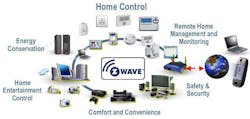Key security takeaways from the Z-Wave Alliance State of the Ecosystem Report
Z-Wave technology was developed almost 20 years ago, and the Z-Wave Alliance was formed just a few years later to create a place where manufacturers integrating the technology could come together to work on new ways to implement Z-Wave, develop certification, and market its strengths and benefits to customers. Since its inception, Z-Wave has stood as a leader in the wireless protocol segment, with a robust certification program, security standards that are among the most rigorous in the industry, and an Alliance made up of a diverse group of manufacturers, integrators, and others all driving forward growth in the residential market, as well as other market verticals, like home security.
In our recently-released 2020 Z-Wave State of the Ecosystem Report, we examine smart home and connected technology – from both within and outside of the home – and explore the industry landscape as it exists today, current and future trends, data, and new opportunities, with an emphasis on the role Z-Wave technology plays in the advancement of the industry.
The security industry continues to play an important role in smart home’s overall growth. According to ADT, the U.S. leads all other nations in smart home security installations, with internet-enabled systems installed in nearly one in five households. Analysts project that American demand for smart home security devices will expand even further in the coming years, becoming an $11 billion industry by 2025.
Here are some of the major takeaways related to physical and network security, from this year’s report:
37% of consumers attribute their smart home purchases to a desire for greater security
Technology has reached a point of maturity in 2020; adoption and consumer education have begun to see consistent growth, particularly with mainstream and new-to-technology consumers. Smart home technology has become pervasive in the way we all live our lives — we reach for digital assistants to help us complete tasks; smart security cameras and systems are a large part of our culture, and technology that was once considered to be reserved for the wealthy or tech-savvy experts is now found on the shelves in large sections of big-box stores and wide swaths of the internet. Consumers are adopting smart home through a security lens – often choosing to start out with a smart doorbell or camera, and then migrating to larger smart home systems.
Three out of four surveyed industry experts agree that security is the most important aspect of the Z-Wave protocol
As part of our report development, we surveyed industry experts across different markets and verticals to get their take on the future of smart home – what they see as challenges, opportunities, and trends to come through 2020 and beyond.
When asked the question, “Which aspect of the Z-Wave protocol do you feel is most important right now (interoperability, backwards compatibility, security, or ecosystem size)?” three out of four surveyed industry experts agreed that network security was most important, proving themselves with points like, “it’s an area that will always require concentration” and “numerous studies indicate that security is a major concern with homeowners/consumers examining the smart home industry… the smart home industry is too small and not mature enough to suffer from these issues without it doing major damage to the growth of the industry.”
Z-Wave technology prioritizes network security
Z-Wave uses industry-standard AES128 encryption, the same protocol used in online banking. The Z-Wave certification process ensures that Z-Wave smart devices are secure. The Z-Wave SDK includes the Z-Wave Security S2 Framework, designed to eliminate the risk of man-in-the-middle attacks and includes an industry-wide accepted secure key exchange using Elliptic Curve Diffie-Hellman. The Z-Wave Security S2 framework is mandatory for all devices certified after April 2, 2017, and there are currently 800+ devices on the market with the best in class S2 framework built-in. Z-Wave devices are the safer, smarter choice for users.
Z-Wave is making smart home safer and more easily accessible
Whether it is a consumer trying to get a new smart security system up-and-running, an integrator installing a whole-home smart system, or a building manager attempting to manage hundreds of smart lighting or comfort devices in an apartment building or hotel — it is critical to the greater success of smart home for there to be tools and educational resources that allow for faster, more streamlined implementation and setup of devices, as well as security requirements that ensure that users and their networks are protected, even as the smart home and networks mature. Safer and smarter technology allows for greater adoption and enjoyment of smart homes for years to come.
Z-Wave certification mandates several features and requirements focused on quicker device and system set-up, as well as a continued focus on best-in-the-industry security. SmartStart is a setup feature that removes the complexity of installation for both consumers and professional installers. SmartStart enabled hubs to recognize any SmartStart enabled accessory device, such as a lock or light, with a quick app scan of its QR code. With SmartStart, the device’s information is already set up inside the hub and pairing is complete prior to a consumer or installer adding product – the setup happens behind the scenes, drastically shortening and simplifying the product setup process. S2 Security is a mandatory security framework that protects devices in a Z-Wave project starting at the hub and across all end devices. Once a product passes the Z-Wave Plus v.2 certification, users have the assurance their devices are protected from cyber-attack on these connected devices.
The latest requirement cites device identification through an LED light on each product to provide visual confirmation that the device is paired correctly. Z-Wave Plus v2 certification will continue to require each device to implement the updated security framework, drive installation simplicity and confirmation.
As we find ourselves heading into the final part of 2020, one thing is for certain – the smart home opportunity has never been stronger, especially as it relates to security integration.
Read more in our full report, available for free download at https://z-wavealliance.org/z-wave-state-of-the-ecosystem-report/.
About the author: Mitch Klein is the executive director of the Z-Wave Alliance
About the Author

